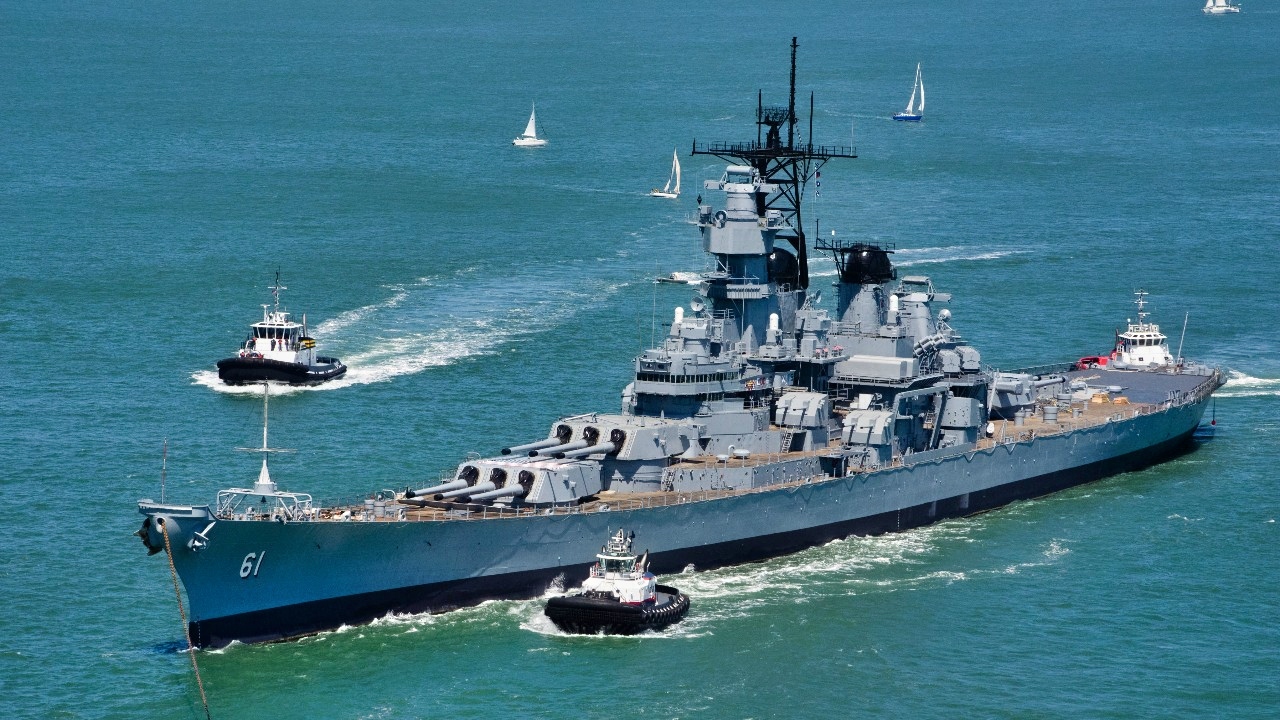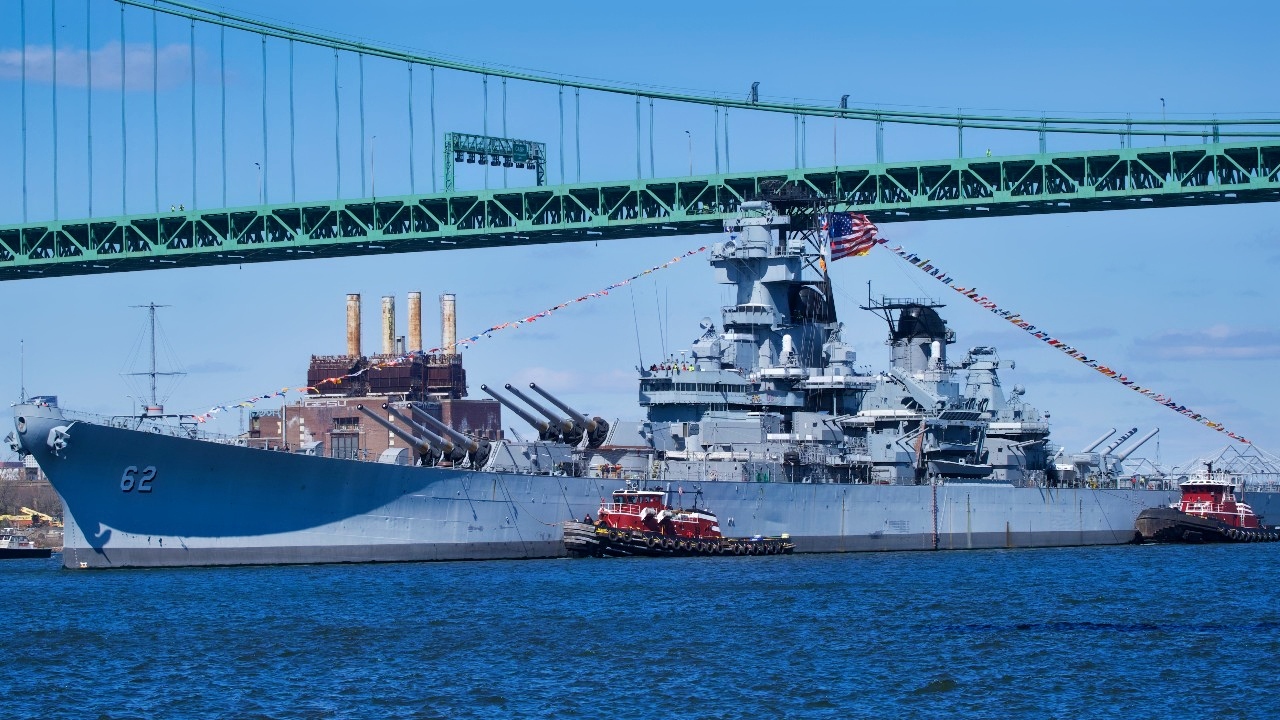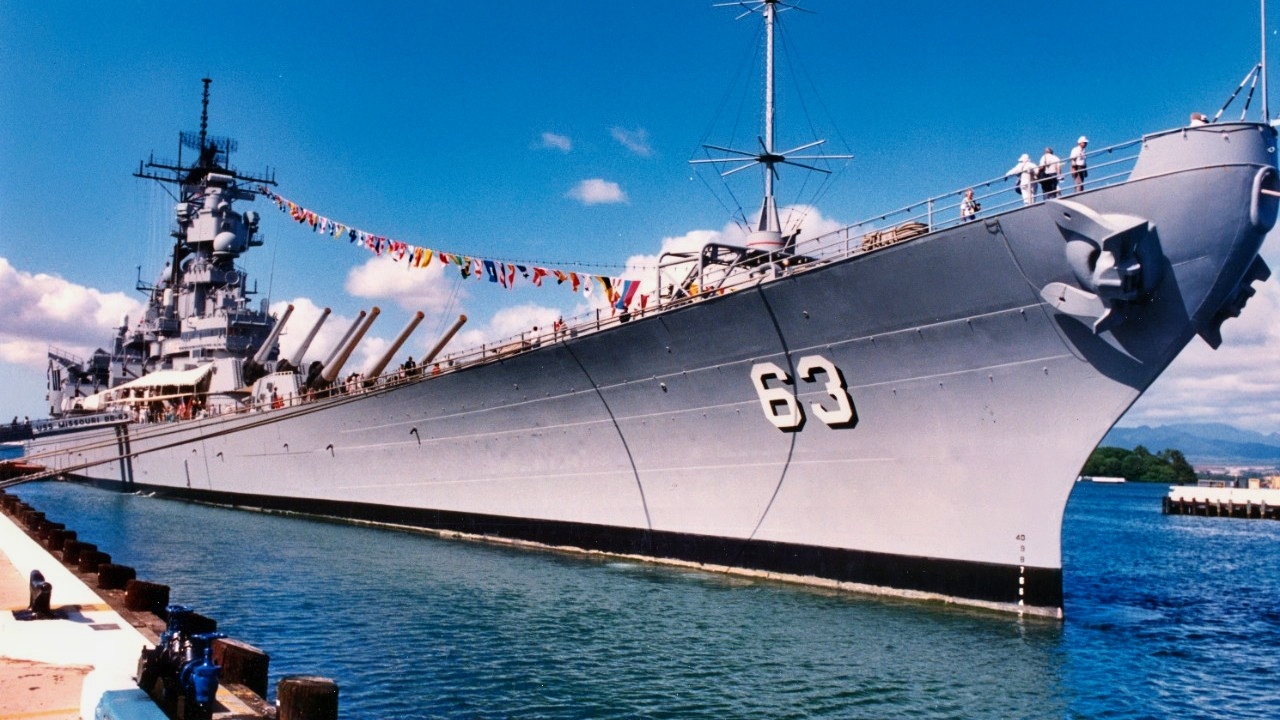Key Points and Summary – During President Ronald Reagan’s 1980s naval buildup, the four legendary Iowa-class battleships were brought out of retirement and given a new lease on life.
-To modernize them for the end of the Cold War, their outdated anti-aircraft guns were replaced with a powerful new arsenal: 32 Tomahawk cruise missiles and 16 Harpoon anti-ship missiles.

Iowa-Class Battleship U.S. Navy Full. Image Credit: Creative Commons.
-This ambitious refit gave the World War II-era dreadnoughts a potent, modern, long-range strike capability.
-These invigorated battleships last saw combat during Operation Desert Storm, firing both their new cruise missiles and their iconic 16-inch guns.
When the Iowa-class Battleships Were Invigorated with Modern Weapons
When contemplating a US Navy battleship from World War II, the Korean War, and the Vietnam War, you likely have images in your mind of the huge, thunderous guns that rumbled throughout the vessel.
These certainly brought down inestimable pain against the enemy in bombardments during those conflicts.
However, you may not know that the Iowa-class battleships were once outfitted with modern weapons in the 1980s, during President Ronald Reagan’s significant naval buildup, aimed at intimidating the Soviets during the final stages of the Cold War.
The idea was to bring in Harpoon anti-ship missiles – 16 of those and 32 Tomahawk cruise missiles. This gave the Iowa-class dreadnoughts a new lease on life, bringing them into the modern age.
Supplementing the 600-ship Navy
The USS Iowa, USS New Jersey, USS Missouri, and USS Wisconsin were back in business.
Reagan wanted a vast 600-ship Navy, and battleships were there for a new mission.

Iowa-Class Battleship USS Iowa. Image Credit: Creative Commons.
This was exciting for fans of battleships who had not been utilized to their full potential in recent years.
They Were Better Able to ‘Break the Enemy’s Toys’
The Iowa-class vessels had many anti-aircraft guns – probably too many – and these could be swapped out for missiles.
The Navy opted for Mk-143 four-missile armored box launchers for the upgrade, and these proved to work well for the new projectiles that would bring the fight to enemy ships and support ground forces with close air support.
In the Army, we used to always joke about “calling in Naval gunfire” to decimate a small, helpless target. Alas, I was never able to do that, but it was fun to imagine the death and destruction that battleships could still create on the modern battlefield.
The Iowa-class battleships also deployed the Harpoon Weapons System. This consisted of four Mk-141 “shock-hardened” four-tube launchers designed to launch the RGM-84 Harpoon anti-ship missile.
The Last Line of Defense
The Iowa-class still required self-defense after the World War II-era anti-aircraft guns were removed. Four modern Phalanx close-in weapons systems (CIWS) for taking out enemy airplanes and missiles that got through the protective screen from escort ships.

USS Missouri Iowa-Class Battleship. Image Credit: Creative Commons.
The Harpoons, Tomahawks, and CIWS needed modern fire control systems, sensors, and radars, so the Iowa-class ships received those updates. These took the longest time to install and integrate.
Lessons Learned from the Falklands War
One conflict influenced Reagan to reconsider, perhaps, his naval buildup, which had brought the battleships back from the brink of extinction.
The short and decisive Falkland Islands War between the United Kingdom and Argentina demonstrated that anti-ship missiles could disable modern vessels.
Argentina made great use of French-made Exocet missiles that were used to damage and sink the Royal Navy destroyer HMS Sheffield in May 1982.
Two more Exocets struck the 15,000-ton commercial ship Atlantic Conveyor later that month. This made the US Navy take notice that its vessels may not be invincible.
Danger from Enemy Anti-ship Missiles
There was a question about the Iowa-class ships. They had immense armor, but could they survive against Soviet anti-ship missiles?

USS New Jersey Iowa-Class Battleship. Image Credit: Creative Commons.
The CIWS would help, but there was apprehension with the Navy about the huge ships. The sinking of an Iowa-class would have been an enormous embarrassment.
It would have brought critics out of the woodwork who would question why the battleships were taken out of mothballs in the first place.
The surface strike capability of the Tomahawks made sense, and the Harpoons would have been highly destructive; however, a battleship loss from an anti-ship missile would have been disastrous.
In 2 Words: Missile Trucks?
I have mixed feelings about bringing the Iowa-class back into service in the 1980s. They were turned into some sort of hybrid battleship/missile truck. Was it worth the costs?
If you want a huge Navy, it makes sense to get your most experienced horses back to the rodeo. The Iowa-class powerhouses were combat-proven and instilled fear in the enemy, but the modern anti-ship missile posed a significant challenge.
Would the CIWS work to save a battleship? The massive vessels could take a hit, but a saturation launch by the Russians could send an Iowa-class down to Davy Jones’ locker.

USS Missouri. Image Credit: Creative Commons.
Perhaps the Iowa-class refit was more for public relations and morale purposes. The general public is often fascinated by battleships for the firepower they represent. They fly the flag with gusto and are a symbol of national might. But they hearkened back to a much different era, especially during World War II, when capital ships were so valuable at prepping landing zones for amphibious warfare.
Fortunately, we’ll never know how the Iowa-class would have fared against the Soviet Navy. The Cold War ended without a shot.
The First Gulf War saw the Wisconsin and the Missouri deployed during Operation Desert Storm, and the Tomahawk cruise missiles and 16-inch guns, with a 27-mile range, were a welcome addition to the fight.
That was the last time battleships saw combat. The weapons upgrade had some upside and was seen as a way to bring old ships into modern warfare in shock and awe situations. Not bad for ships that were originally designed to fight the Japanese and Nazis.
About the Author: Brent M. Eastwood
Brent M. Eastwood, PhD is the author of Don’t Turn Your Back On the World: a Conservative Foreign Policy and Humans, Machines, and Data: Future Trends in Warfare plus two other books. Brent was the founder and CEO of a tech firm that predicted world events using artificial intelligence. He served as a legislative fellow for US Senator Tim Scott and advised the senator on defense and foreign policy issues. He has taught at American University, George Washington University, and George Mason University. Brent is a former US Army Infantry officer. He can be followed on X @BMEastwood.
More Military
The U.S. Navy’s ‘Achilles Heel’: China’s Underwater Drones
The F-35 Has a ‘5-Year Late’ Problem
X-37B: Russia Thinks This is a Space Bomber











USN Veteran
September 2, 2025 at 1:47 pm
Personally I think it would be good to have a few parked off Yemen. FLY NAVY!!!
Ralph Thomas Howarth
September 4, 2025 at 2:08 pm
I was in harbor with the USS Missouri during the late 80s and knew some crew members. The retrofit Iowa Class battlewagons brought two lessor known advantages. All along these ships could put enough ordnance down on targets within range than 2 aircraft carriers. But they also provided radio coverage and transmission power via its high kw power plant that allowed two fleets to stay in contact across an ocean.